Sustainable Tourism: Analyzing Environment, Stakeholders, and Industry
VerifiedAdded on 2023/06/07
|9
|2777
|221
Essay
AI Summary
This essay delves into the concept of sustainable tourism, emphasizing its principles for development within a destination country. It provides a stakeholder analysis, identifying key players involved in decision-making processes related to sustainable tourism. The essay also examines macro-environmental factors, such as political, economic, social, and technological aspects, that contribute to sustainable tourism development. Furthermore, it describes the competitive micro-environment and explores factors that influence the demand for tourism-related services, including customer preferences, competitor strategies, and intrinsic motivational factors for tourists. The conclusion highlights the importance of the tourism industry in economic growth and the crucial role of sustainable practices and stakeholder collaboration in achieving industry goals.
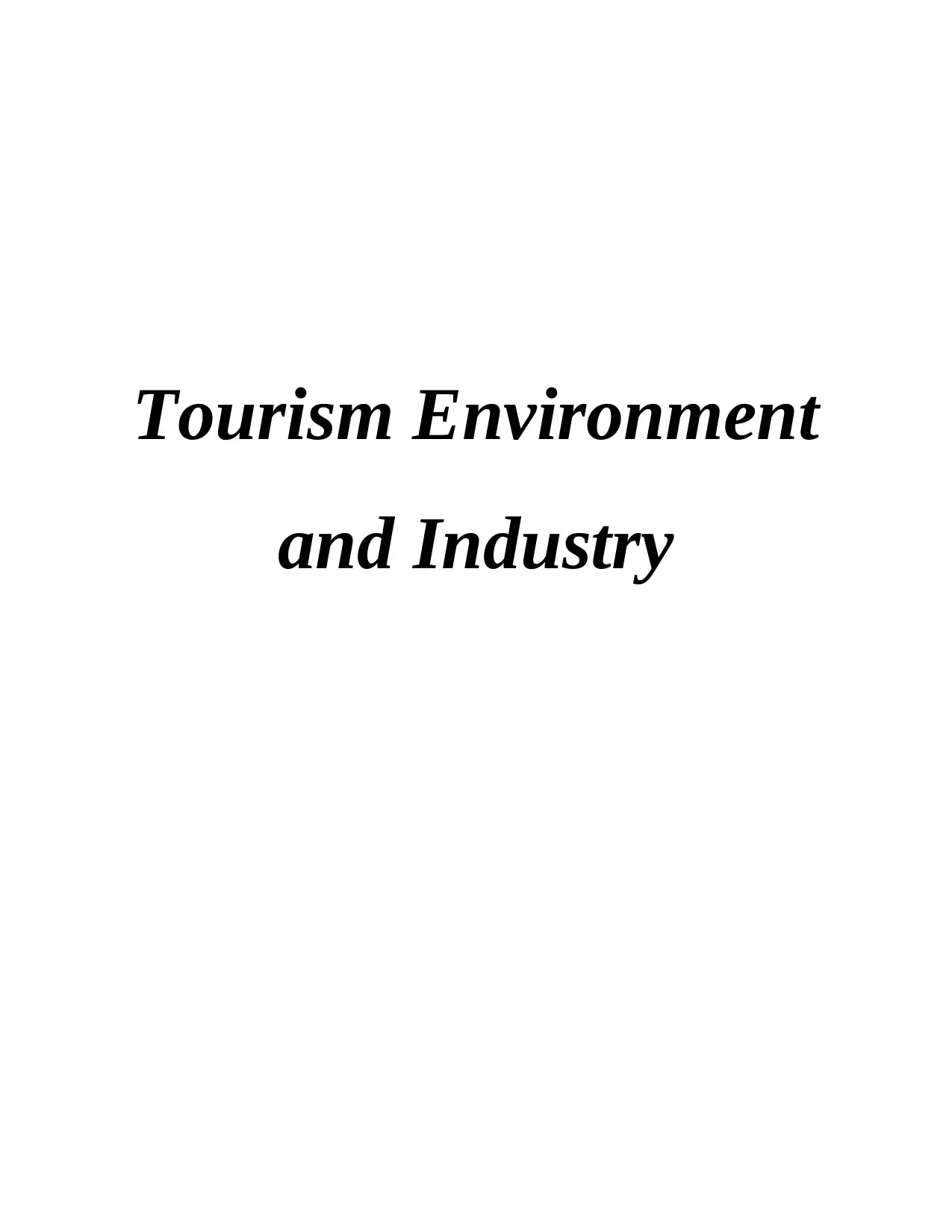
Tourism Environment
and Industry
and Industry
Paraphrase This Document
Need a fresh take? Get an instant paraphrase of this document with our AI Paraphraser
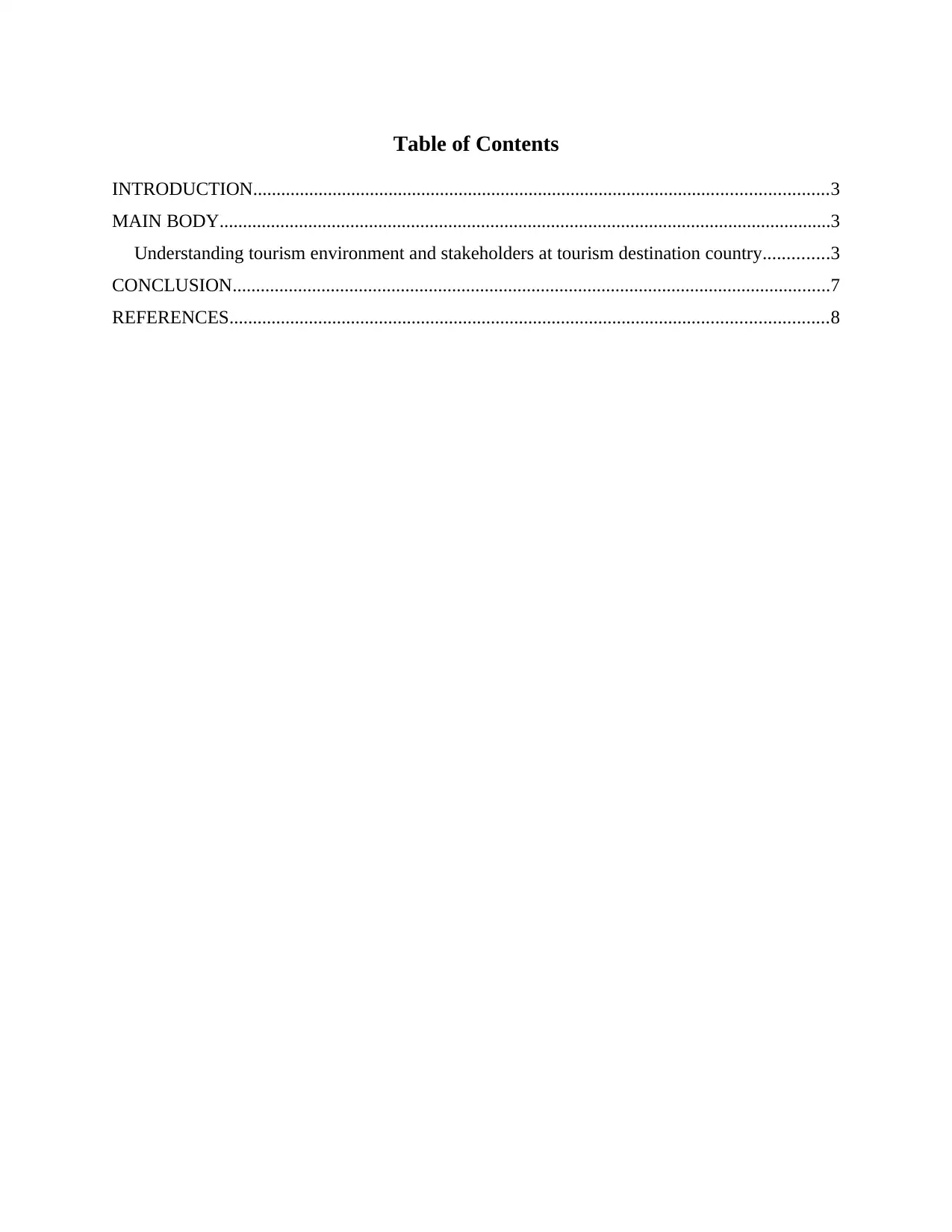
Table of Contents
INTRODUCTION...........................................................................................................................3
MAIN BODY...................................................................................................................................3
Understanding tourism environment and stakeholders at tourism destination country..............3
CONCLUSION................................................................................................................................7
REFERENCES................................................................................................................................8
INTRODUCTION...........................................................................................................................3
MAIN BODY...................................................................................................................................3
Understanding tourism environment and stakeholders at tourism destination country..............3
CONCLUSION................................................................................................................................7
REFERENCES................................................................................................................................8
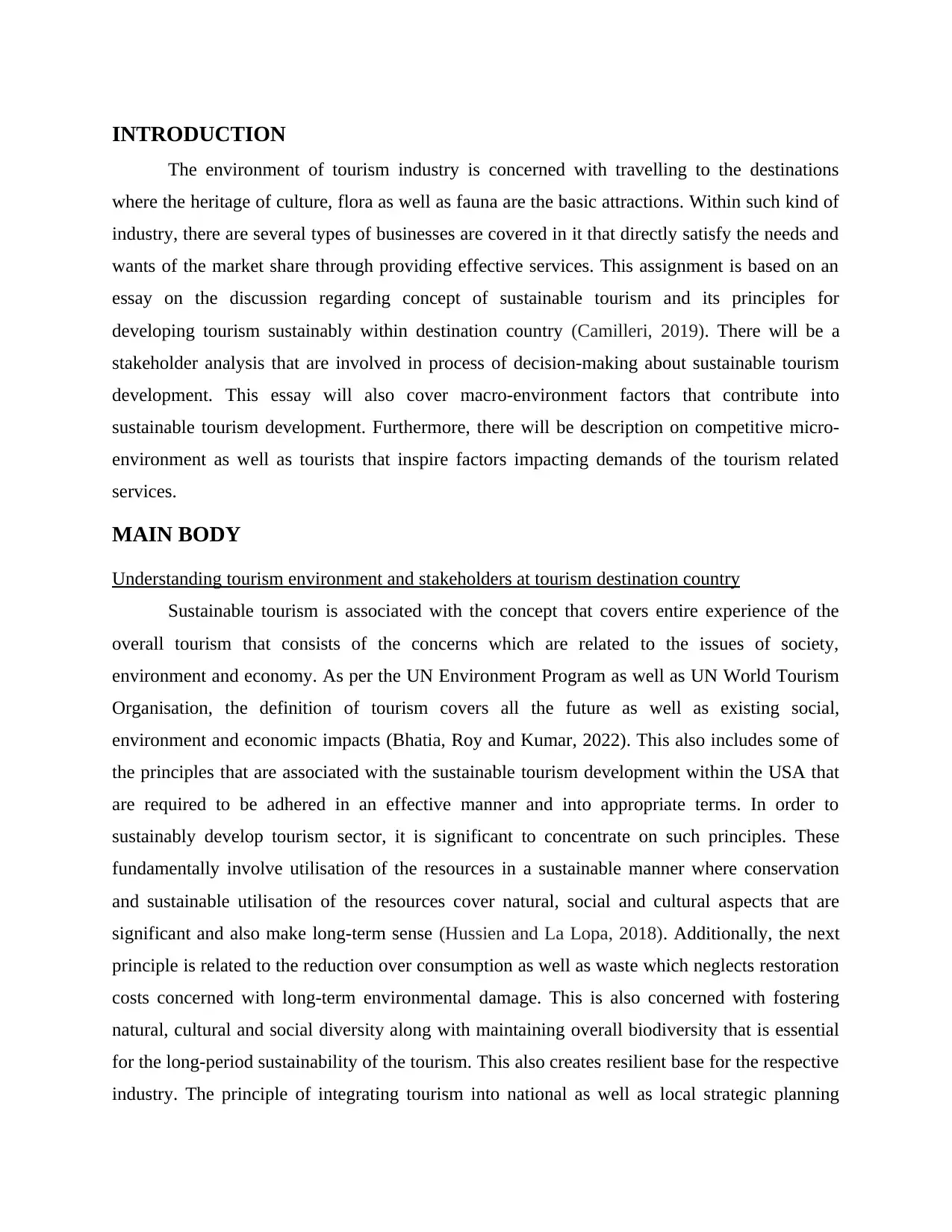
INTRODUCTION
The environment of tourism industry is concerned with travelling to the destinations
where the heritage of culture, flora as well as fauna are the basic attractions. Within such kind of
industry, there are several types of businesses are covered in it that directly satisfy the needs and
wants of the market share through providing effective services. This assignment is based on an
essay on the discussion regarding concept of sustainable tourism and its principles for
developing tourism sustainably within destination country (Camilleri, 2019). There will be a
stakeholder analysis that are involved in process of decision-making about sustainable tourism
development. This essay will also cover macro-environment factors that contribute into
sustainable tourism development. Furthermore, there will be description on competitive micro-
environment as well as tourists that inspire factors impacting demands of the tourism related
services.
MAIN BODY
Understanding tourism environment and stakeholders at tourism destination country
Sustainable tourism is associated with the concept that covers entire experience of the
overall tourism that consists of the concerns which are related to the issues of society,
environment and economy. As per the UN Environment Program as well as UN World Tourism
Organisation, the definition of tourism covers all the future as well as existing social,
environment and economic impacts (Bhatia, Roy and Kumar, 2022). This also includes some of
the principles that are associated with the sustainable tourism development within the USA that
are required to be adhered in an effective manner and into appropriate terms. In order to
sustainably develop tourism sector, it is significant to concentrate on such principles. These
fundamentally involve utilisation of the resources in a sustainable manner where conservation
and sustainable utilisation of the resources cover natural, social and cultural aspects that are
significant and also make long-term sense (Hussien and La Lopa, 2018). Additionally, the next
principle is related to the reduction over consumption as well as waste which neglects restoration
costs concerned with long-term environmental damage. This is also concerned with fostering
natural, cultural and social diversity along with maintaining overall biodiversity that is essential
for the long-period sustainability of the tourism. This also creates resilient base for the respective
industry. The principle of integrating tourism into national as well as local strategic planning
The environment of tourism industry is concerned with travelling to the destinations
where the heritage of culture, flora as well as fauna are the basic attractions. Within such kind of
industry, there are several types of businesses are covered in it that directly satisfy the needs and
wants of the market share through providing effective services. This assignment is based on an
essay on the discussion regarding concept of sustainable tourism and its principles for
developing tourism sustainably within destination country (Camilleri, 2019). There will be a
stakeholder analysis that are involved in process of decision-making about sustainable tourism
development. This essay will also cover macro-environment factors that contribute into
sustainable tourism development. Furthermore, there will be description on competitive micro-
environment as well as tourists that inspire factors impacting demands of the tourism related
services.
MAIN BODY
Understanding tourism environment and stakeholders at tourism destination country
Sustainable tourism is associated with the concept that covers entire experience of the
overall tourism that consists of the concerns which are related to the issues of society,
environment and economy. As per the UN Environment Program as well as UN World Tourism
Organisation, the definition of tourism covers all the future as well as existing social,
environment and economic impacts (Bhatia, Roy and Kumar, 2022). This also includes some of
the principles that are associated with the sustainable tourism development within the USA that
are required to be adhered in an effective manner and into appropriate terms. In order to
sustainably develop tourism sector, it is significant to concentrate on such principles. These
fundamentally involve utilisation of the resources in a sustainable manner where conservation
and sustainable utilisation of the resources cover natural, social and cultural aspects that are
significant and also make long-term sense (Hussien and La Lopa, 2018). Additionally, the next
principle is related to the reduction over consumption as well as waste which neglects restoration
costs concerned with long-term environmental damage. This is also concerned with fostering
natural, cultural and social diversity along with maintaining overall biodiversity that is essential
for the long-period sustainability of the tourism. This also creates resilient base for the respective
industry. The principle of integrating tourism into national as well as local strategic planning
⊘ This is a preview!⊘
Do you want full access?
Subscribe today to unlock all pages.

Trusted by 1+ million students worldwide
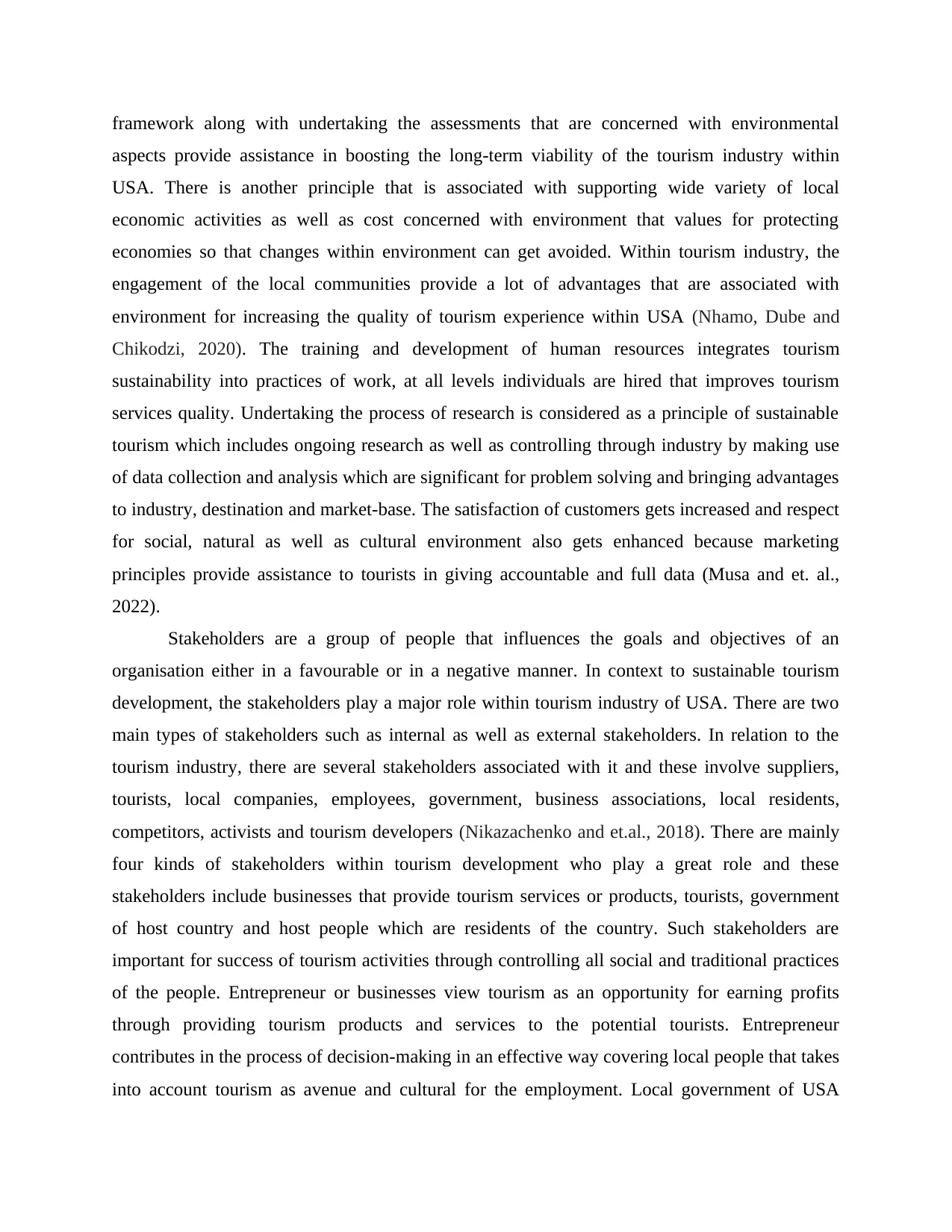
framework along with undertaking the assessments that are concerned with environmental
aspects provide assistance in boosting the long-term viability of the tourism industry within
USA. There is another principle that is associated with supporting wide variety of local
economic activities as well as cost concerned with environment that values for protecting
economies so that changes within environment can get avoided. Within tourism industry, the
engagement of the local communities provide a lot of advantages that are associated with
environment for increasing the quality of tourism experience within USA (Nhamo, Dube and
Chikodzi, 2020). The training and development of human resources integrates tourism
sustainability into practices of work, at all levels individuals are hired that improves tourism
services quality. Undertaking the process of research is considered as a principle of sustainable
tourism which includes ongoing research as well as controlling through industry by making use
of data collection and analysis which are significant for problem solving and bringing advantages
to industry, destination and market-base. The satisfaction of customers gets increased and respect
for social, natural as well as cultural environment also gets enhanced because marketing
principles provide assistance to tourists in giving accountable and full data (Musa and et. al.,
2022).
Stakeholders are a group of people that influences the goals and objectives of an
organisation either in a favourable or in a negative manner. In context to sustainable tourism
development, the stakeholders play a major role within tourism industry of USA. There are two
main types of stakeholders such as internal as well as external stakeholders. In relation to the
tourism industry, there are several stakeholders associated with it and these involve suppliers,
tourists, local companies, employees, government, business associations, local residents,
competitors, activists and tourism developers (Nikazachenko and et.al., 2018). There are mainly
four kinds of stakeholders within tourism development who play a great role and these
stakeholders include businesses that provide tourism services or products, tourists, government
of host country and host people which are residents of the country. Such stakeholders are
important for success of tourism activities through controlling all social and traditional practices
of the people. Entrepreneur or businesses view tourism as an opportunity for earning profits
through providing tourism products and services to the potential tourists. Entrepreneur
contributes in the process of decision-making in an effective way covering local people that takes
into account tourism as avenue and cultural for the employment. Local government of USA
aspects provide assistance in boosting the long-term viability of the tourism industry within
USA. There is another principle that is associated with supporting wide variety of local
economic activities as well as cost concerned with environment that values for protecting
economies so that changes within environment can get avoided. Within tourism industry, the
engagement of the local communities provide a lot of advantages that are associated with
environment for increasing the quality of tourism experience within USA (Nhamo, Dube and
Chikodzi, 2020). The training and development of human resources integrates tourism
sustainability into practices of work, at all levels individuals are hired that improves tourism
services quality. Undertaking the process of research is considered as a principle of sustainable
tourism which includes ongoing research as well as controlling through industry by making use
of data collection and analysis which are significant for problem solving and bringing advantages
to industry, destination and market-base. The satisfaction of customers gets increased and respect
for social, natural as well as cultural environment also gets enhanced because marketing
principles provide assistance to tourists in giving accountable and full data (Musa and et. al.,
2022).
Stakeholders are a group of people that influences the goals and objectives of an
organisation either in a favourable or in a negative manner. In context to sustainable tourism
development, the stakeholders play a major role within tourism industry of USA. There are two
main types of stakeholders such as internal as well as external stakeholders. In relation to the
tourism industry, there are several stakeholders associated with it and these involve suppliers,
tourists, local companies, employees, government, business associations, local residents,
competitors, activists and tourism developers (Nikazachenko and et.al., 2018). There are mainly
four kinds of stakeholders within tourism development who play a great role and these
stakeholders include businesses that provide tourism services or products, tourists, government
of host country and host people which are residents of the country. Such stakeholders are
important for success of tourism activities through controlling all social and traditional practices
of the people. Entrepreneur or businesses view tourism as an opportunity for earning profits
through providing tourism products and services to the potential tourists. Entrepreneur
contributes in the process of decision-making in an effective way covering local people that takes
into account tourism as avenue and cultural for the employment. Local government of USA
Paraphrase This Document
Need a fresh take? Get an instant paraphrase of this document with our AI Paraphraser
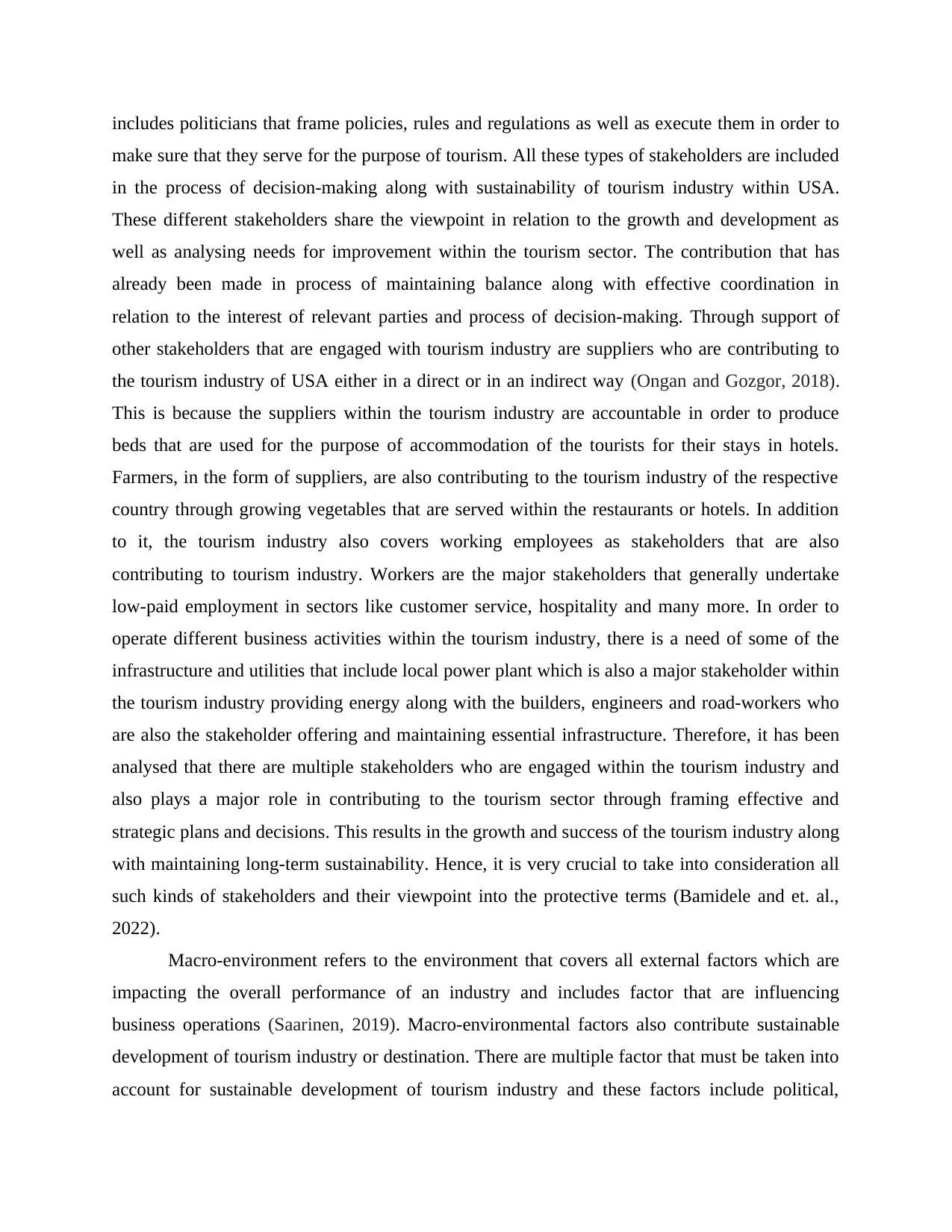
includes politicians that frame policies, rules and regulations as well as execute them in order to
make sure that they serve for the purpose of tourism. All these types of stakeholders are included
in the process of decision-making along with sustainability of tourism industry within USA.
These different stakeholders share the viewpoint in relation to the growth and development as
well as analysing needs for improvement within the tourism sector. The contribution that has
already been made in process of maintaining balance along with effective coordination in
relation to the interest of relevant parties and process of decision-making. Through support of
other stakeholders that are engaged with tourism industry are suppliers who are contributing to
the tourism industry of USA either in a direct or in an indirect way (Ongan and Gozgor, 2018).
This is because the suppliers within the tourism industry are accountable in order to produce
beds that are used for the purpose of accommodation of the tourists for their stays in hotels.
Farmers, in the form of suppliers, are also contributing to the tourism industry of the respective
country through growing vegetables that are served within the restaurants or hotels. In addition
to it, the tourism industry also covers working employees as stakeholders that are also
contributing to tourism industry. Workers are the major stakeholders that generally undertake
low-paid employment in sectors like customer service, hospitality and many more. In order to
operate different business activities within the tourism industry, there is a need of some of the
infrastructure and utilities that include local power plant which is also a major stakeholder within
the tourism industry providing energy along with the builders, engineers and road-workers who
are also the stakeholder offering and maintaining essential infrastructure. Therefore, it has been
analysed that there are multiple stakeholders who are engaged within the tourism industry and
also plays a major role in contributing to the tourism sector through framing effective and
strategic plans and decisions. This results in the growth and success of the tourism industry along
with maintaining long-term sustainability. Hence, it is very crucial to take into consideration all
such kinds of stakeholders and their viewpoint into the protective terms (Bamidele and et. al.,
2022).
Macro-environment refers to the environment that covers all external factors which are
impacting the overall performance of an industry and includes factor that are influencing
business operations (Saarinen, 2019). Macro-environmental factors also contribute sustainable
development of tourism industry or destination. There are multiple factor that must be taken into
account for sustainable development of tourism industry and these factors include political,
make sure that they serve for the purpose of tourism. All these types of stakeholders are included
in the process of decision-making along with sustainability of tourism industry within USA.
These different stakeholders share the viewpoint in relation to the growth and development as
well as analysing needs for improvement within the tourism sector. The contribution that has
already been made in process of maintaining balance along with effective coordination in
relation to the interest of relevant parties and process of decision-making. Through support of
other stakeholders that are engaged with tourism industry are suppliers who are contributing to
the tourism industry of USA either in a direct or in an indirect way (Ongan and Gozgor, 2018).
This is because the suppliers within the tourism industry are accountable in order to produce
beds that are used for the purpose of accommodation of the tourists for their stays in hotels.
Farmers, in the form of suppliers, are also contributing to the tourism industry of the respective
country through growing vegetables that are served within the restaurants or hotels. In addition
to it, the tourism industry also covers working employees as stakeholders that are also
contributing to tourism industry. Workers are the major stakeholders that generally undertake
low-paid employment in sectors like customer service, hospitality and many more. In order to
operate different business activities within the tourism industry, there is a need of some of the
infrastructure and utilities that include local power plant which is also a major stakeholder within
the tourism industry providing energy along with the builders, engineers and road-workers who
are also the stakeholder offering and maintaining essential infrastructure. Therefore, it has been
analysed that there are multiple stakeholders who are engaged within the tourism industry and
also plays a major role in contributing to the tourism sector through framing effective and
strategic plans and decisions. This results in the growth and success of the tourism industry along
with maintaining long-term sustainability. Hence, it is very crucial to take into consideration all
such kinds of stakeholders and their viewpoint into the protective terms (Bamidele and et. al.,
2022).
Macro-environment refers to the environment that covers all external factors which are
impacting the overall performance of an industry and includes factor that are influencing
business operations (Saarinen, 2019). Macro-environmental factors also contribute sustainable
development of tourism industry or destination. There are multiple factor that must be taken into
account for sustainable development of tourism industry and these factors include political,

economic, social, technological, legal and environmental. Political factor should be considered
for tourism industry development as there are less rules and regulations and strong political
stability within USA. Political system of this country frames rules and regulations for its tourism
industry and has great impact on demand for travel that get much attention to tourism industry.
In relation to economic factor, tourism industry within USA generated $1.9 trillion in economic
output which has created strong GDP of the country. Millions of tourists are attracted each year
that contributes USA economy crucially. This country also has varied social market which
provide equal opportunities for all types of businesses to flourish and grow as they have
diversified demands of products and services in tourism industry that enhances industry's
profitability (Shasha and et.al., 2020). As per technological factor, USA has highly developed
technological environment for introducing effective services and tourism related products.
Within tourism industry, organisations often develop new technologies for providing best
services to market-base with the help of technological infrastructure that offers businesses wide
opportunities for conducting business within USA which positively impacts performance of
tourism industry of USA. Henceforth, this is observed that factors associated with macro-
environment plays a significant role in the process of further development and growth of the
tourism development into specific economy of USA. This also provide assistance in the process
of taking effective decisions as well as contributing within it in a favourable manner (Shilova
and et. al., 2022).
There are multiple factors that are concerned with micro-environment which motivates or
influence demands of the tourism related products and services. There are certain micro-
environmental factors that are required to be taken into consideration and these factors consist of
customers, workers, competitors, suppliers, public, market intermediaries and union, etc. The
products and services concerned with tourism include transportation, accommodation, retail
travel agents, tour operators, cinema theatres, shopping centres, tourism information centres and
restaurants. Demand of tourism services gets influenced through competitive factors that are
associated with micro-environment which should be taken into account (Willie, 2019). Tourism
industry cover several customers with various preferences that impact demand of tourism
services so that these should be in accordance with customer needs. Tourism industry gets also
influenced through multiple competitors that are always suggested for generating new ideas to
maintain demand level in industry along with tough competition which can be given to other
for tourism industry development as there are less rules and regulations and strong political
stability within USA. Political system of this country frames rules and regulations for its tourism
industry and has great impact on demand for travel that get much attention to tourism industry.
In relation to economic factor, tourism industry within USA generated $1.9 trillion in economic
output which has created strong GDP of the country. Millions of tourists are attracted each year
that contributes USA economy crucially. This country also has varied social market which
provide equal opportunities for all types of businesses to flourish and grow as they have
diversified demands of products and services in tourism industry that enhances industry's
profitability (Shasha and et.al., 2020). As per technological factor, USA has highly developed
technological environment for introducing effective services and tourism related products.
Within tourism industry, organisations often develop new technologies for providing best
services to market-base with the help of technological infrastructure that offers businesses wide
opportunities for conducting business within USA which positively impacts performance of
tourism industry of USA. Henceforth, this is observed that factors associated with macro-
environment plays a significant role in the process of further development and growth of the
tourism development into specific economy of USA. This also provide assistance in the process
of taking effective decisions as well as contributing within it in a favourable manner (Shilova
and et. al., 2022).
There are multiple factors that are concerned with micro-environment which motivates or
influence demands of the tourism related products and services. There are certain micro-
environmental factors that are required to be taken into consideration and these factors consist of
customers, workers, competitors, suppliers, public, market intermediaries and union, etc. The
products and services concerned with tourism include transportation, accommodation, retail
travel agents, tour operators, cinema theatres, shopping centres, tourism information centres and
restaurants. Demand of tourism services gets influenced through competitive factors that are
associated with micro-environment which should be taken into account (Willie, 2019). Tourism
industry cover several customers with various preferences that impact demand of tourism
services so that these should be in accordance with customer needs. Tourism industry gets also
influenced through multiple competitors that are always suggested for generating new ideas to
maintain demand level in industry along with tough competition which can be given to other
⊘ This is a preview!⊘
Do you want full access?
Subscribe today to unlock all pages.

Trusted by 1+ million students worldwide
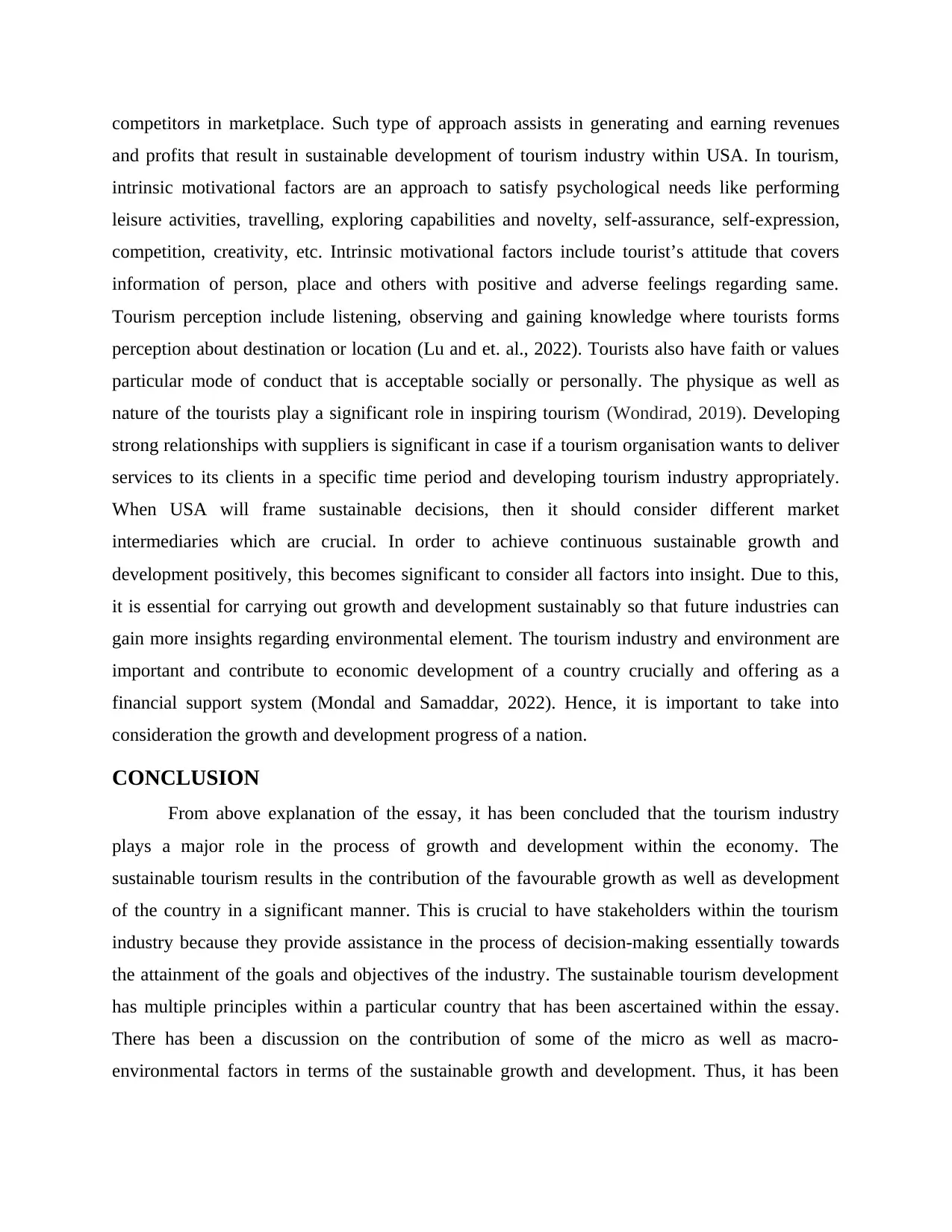
competitors in marketplace. Such type of approach assists in generating and earning revenues
and profits that result in sustainable development of tourism industry within USA. In tourism,
intrinsic motivational factors are an approach to satisfy psychological needs like performing
leisure activities, travelling, exploring capabilities and novelty, self-assurance, self-expression,
competition, creativity, etc. Intrinsic motivational factors include tourist’s attitude that covers
information of person, place and others with positive and adverse feelings regarding same.
Tourism perception include listening, observing and gaining knowledge where tourists forms
perception about destination or location (Lu and et. al., 2022). Tourists also have faith or values
particular mode of conduct that is acceptable socially or personally. The physique as well as
nature of the tourists play a significant role in inspiring tourism (Wondirad, 2019). Developing
strong relationships with suppliers is significant in case if a tourism organisation wants to deliver
services to its clients in a specific time period and developing tourism industry appropriately.
When USA will frame sustainable decisions, then it should consider different market
intermediaries which are crucial. In order to achieve continuous sustainable growth and
development positively, this becomes significant to consider all factors into insight. Due to this,
it is essential for carrying out growth and development sustainably so that future industries can
gain more insights regarding environmental element. The tourism industry and environment are
important and contribute to economic development of a country crucially and offering as a
financial support system (Mondal and Samaddar, 2022). Hence, it is important to take into
consideration the growth and development progress of a nation.
CONCLUSION
From above explanation of the essay, it has been concluded that the tourism industry
plays a major role in the process of growth and development within the economy. The
sustainable tourism results in the contribution of the favourable growth as well as development
of the country in a significant manner. This is crucial to have stakeholders within the tourism
industry because they provide assistance in the process of decision-making essentially towards
the attainment of the goals and objectives of the industry. The sustainable tourism development
has multiple principles within a particular country that has been ascertained within the essay.
There has been a discussion on the contribution of some of the micro as well as macro-
environmental factors in terms of the sustainable growth and development. Thus, it has been
and profits that result in sustainable development of tourism industry within USA. In tourism,
intrinsic motivational factors are an approach to satisfy psychological needs like performing
leisure activities, travelling, exploring capabilities and novelty, self-assurance, self-expression,
competition, creativity, etc. Intrinsic motivational factors include tourist’s attitude that covers
information of person, place and others with positive and adverse feelings regarding same.
Tourism perception include listening, observing and gaining knowledge where tourists forms
perception about destination or location (Lu and et. al., 2022). Tourists also have faith or values
particular mode of conduct that is acceptable socially or personally. The physique as well as
nature of the tourists play a significant role in inspiring tourism (Wondirad, 2019). Developing
strong relationships with suppliers is significant in case if a tourism organisation wants to deliver
services to its clients in a specific time period and developing tourism industry appropriately.
When USA will frame sustainable decisions, then it should consider different market
intermediaries which are crucial. In order to achieve continuous sustainable growth and
development positively, this becomes significant to consider all factors into insight. Due to this,
it is essential for carrying out growth and development sustainably so that future industries can
gain more insights regarding environmental element. The tourism industry and environment are
important and contribute to economic development of a country crucially and offering as a
financial support system (Mondal and Samaddar, 2022). Hence, it is important to take into
consideration the growth and development progress of a nation.
CONCLUSION
From above explanation of the essay, it has been concluded that the tourism industry
plays a major role in the process of growth and development within the economy. The
sustainable tourism results in the contribution of the favourable growth as well as development
of the country in a significant manner. This is crucial to have stakeholders within the tourism
industry because they provide assistance in the process of decision-making essentially towards
the attainment of the goals and objectives of the industry. The sustainable tourism development
has multiple principles within a particular country that has been ascertained within the essay.
There has been a discussion on the contribution of some of the micro as well as macro-
environmental factors in terms of the sustainable growth and development. Thus, it has been
Paraphrase This Document
Need a fresh take? Get an instant paraphrase of this document with our AI Paraphraser

required to take corrective actions and frame effective as well as strategic plans to develop
sustainable tourism industry within selected destination.
sustainable tourism industry within selected destination.
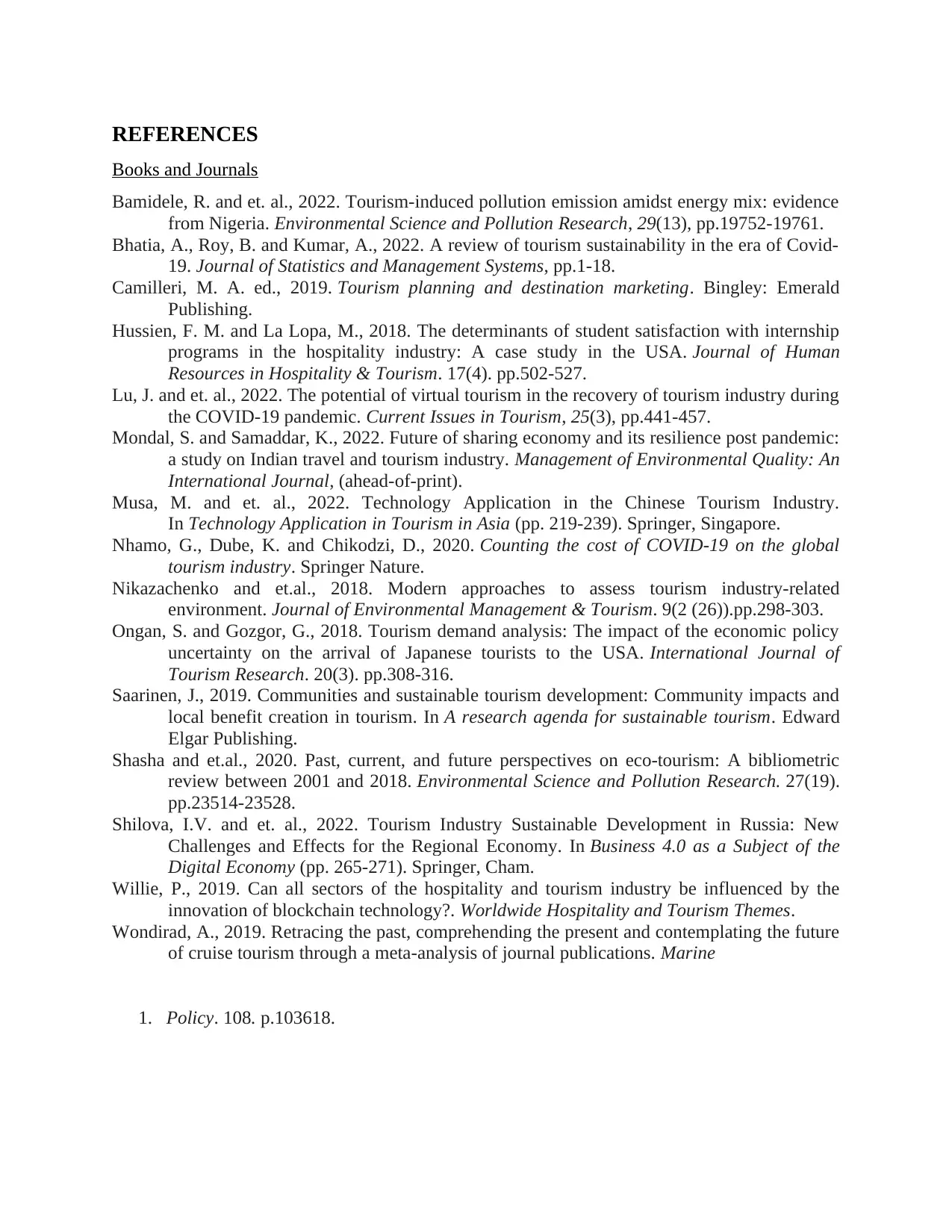
REFERENCES
Books and Journals
Bamidele, R. and et. al., 2022. Tourism-induced pollution emission amidst energy mix: evidence
from Nigeria. Environmental Science and Pollution Research, 29(13), pp.19752-19761.
Bhatia, A., Roy, B. and Kumar, A., 2022. A review of tourism sustainability in the era of Covid-
19. Journal of Statistics and Management Systems, pp.1-18.
Camilleri, M. A. ed., 2019. Tourism planning and destination marketing. Bingley: Emerald
Publishing.
Hussien, F. M. and La Lopa, M., 2018. The determinants of student satisfaction with internship
programs in the hospitality industry: A case study in the USA. Journal of Human
Resources in Hospitality & Tourism. 17(4). pp.502-527.
Lu, J. and et. al., 2022. The potential of virtual tourism in the recovery of tourism industry during
the COVID-19 pandemic. Current Issues in Tourism, 25(3), pp.441-457.
Mondal, S. and Samaddar, K., 2022. Future of sharing economy and its resilience post pandemic:
a study on Indian travel and tourism industry. Management of Environmental Quality: An
International Journal, (ahead-of-print).
Musa, M. and et. al., 2022. Technology Application in the Chinese Tourism Industry.
In Technology Application in Tourism in Asia (pp. 219-239). Springer, Singapore.
Nhamo, G., Dube, K. and Chikodzi, D., 2020. Counting the cost of COVID-19 on the global
tourism industry. Springer Nature.
Nikazachenko and et.al., 2018. Modern approaches to assess tourism industry-related
environment. Journal of Environmental Management & Tourism. 9(2 (26)).pp.298-303.
Ongan, S. and Gozgor, G., 2018. Tourism demand analysis: The impact of the economic policy
uncertainty on the arrival of Japanese tourists to the USA. International Journal of
Tourism Research. 20(3). pp.308-316.
Saarinen, J., 2019. Communities and sustainable tourism development: Community impacts and
local benefit creation in tourism. In A research agenda for sustainable tourism. Edward
Elgar Publishing.
Shasha and et.al., 2020. Past, current, and future perspectives on eco-tourism: A bibliometric
review between 2001 and 2018. Environmental Science and Pollution Research. 27(19).
pp.23514-23528.
Shilova, I.V. and et. al., 2022. Tourism Industry Sustainable Development in Russia: New
Challenges and Effects for the Regional Economy. In Business 4.0 as a Subject of the
Digital Economy (pp. 265-271). Springer, Cham.
Willie, P., 2019. Can all sectors of the hospitality and tourism industry be influenced by the
innovation of blockchain technology?. Worldwide Hospitality and Tourism Themes.
Wondirad, A., 2019. Retracing the past, comprehending the present and contemplating the future
of cruise tourism through a meta-analysis of journal publications. Marine
1. Policy. 108. p.103618.
Books and Journals
Bamidele, R. and et. al., 2022. Tourism-induced pollution emission amidst energy mix: evidence
from Nigeria. Environmental Science and Pollution Research, 29(13), pp.19752-19761.
Bhatia, A., Roy, B. and Kumar, A., 2022. A review of tourism sustainability in the era of Covid-
19. Journal of Statistics and Management Systems, pp.1-18.
Camilleri, M. A. ed., 2019. Tourism planning and destination marketing. Bingley: Emerald
Publishing.
Hussien, F. M. and La Lopa, M., 2018. The determinants of student satisfaction with internship
programs in the hospitality industry: A case study in the USA. Journal of Human
Resources in Hospitality & Tourism. 17(4). pp.502-527.
Lu, J. and et. al., 2022. The potential of virtual tourism in the recovery of tourism industry during
the COVID-19 pandemic. Current Issues in Tourism, 25(3), pp.441-457.
Mondal, S. and Samaddar, K., 2022. Future of sharing economy and its resilience post pandemic:
a study on Indian travel and tourism industry. Management of Environmental Quality: An
International Journal, (ahead-of-print).
Musa, M. and et. al., 2022. Technology Application in the Chinese Tourism Industry.
In Technology Application in Tourism in Asia (pp. 219-239). Springer, Singapore.
Nhamo, G., Dube, K. and Chikodzi, D., 2020. Counting the cost of COVID-19 on the global
tourism industry. Springer Nature.
Nikazachenko and et.al., 2018. Modern approaches to assess tourism industry-related
environment. Journal of Environmental Management & Tourism. 9(2 (26)).pp.298-303.
Ongan, S. and Gozgor, G., 2018. Tourism demand analysis: The impact of the economic policy
uncertainty on the arrival of Japanese tourists to the USA. International Journal of
Tourism Research. 20(3). pp.308-316.
Saarinen, J., 2019. Communities and sustainable tourism development: Community impacts and
local benefit creation in tourism. In A research agenda for sustainable tourism. Edward
Elgar Publishing.
Shasha and et.al., 2020. Past, current, and future perspectives on eco-tourism: A bibliometric
review between 2001 and 2018. Environmental Science and Pollution Research. 27(19).
pp.23514-23528.
Shilova, I.V. and et. al., 2022. Tourism Industry Sustainable Development in Russia: New
Challenges and Effects for the Regional Economy. In Business 4.0 as a Subject of the
Digital Economy (pp. 265-271). Springer, Cham.
Willie, P., 2019. Can all sectors of the hospitality and tourism industry be influenced by the
innovation of blockchain technology?. Worldwide Hospitality and Tourism Themes.
Wondirad, A., 2019. Retracing the past, comprehending the present and contemplating the future
of cruise tourism through a meta-analysis of journal publications. Marine
1. Policy. 108. p.103618.
⊘ This is a preview!⊘
Do you want full access?
Subscribe today to unlock all pages.

Trusted by 1+ million students worldwide
1 out of 9
Related Documents
Your All-in-One AI-Powered Toolkit for Academic Success.
+13062052269
info@desklib.com
Available 24*7 on WhatsApp / Email
![[object Object]](/_next/static/media/star-bottom.7253800d.svg)
Unlock your academic potential
Copyright © 2020–2026 A2Z Services. All Rights Reserved. Developed and managed by ZUCOL.



